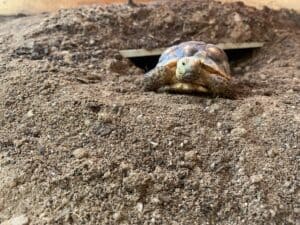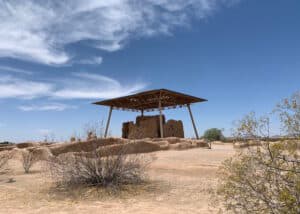It has been one month since we adopted our Sonoran desert tortoise from Arizona Fish and Game Department. Meet Finn. We don't know if Finn is a boy or girl and will not know until Fin is about 10 years old. Fin is currently 1 year of age. Finn is a super low key pet. Our tortoise lives in our backyard in an enclosure. Once it gets bigger, Finn will be able to roam freely in the yard. In the first week of having our tortoise we found Finn flipped over upside down three times. This can be super dangerous especially for the baby tortoises. They will release their bladders when upside down and can quickly become dehydrated. After finding Finn flipped so many times we decided it would be best to redo the burrow again and add extra dirt in the enclosure. I have lost count at this point how many times we have remade the burrow. And this last time we got it just right. It is the perfect size and after some pretty heavy rains also stays dry. Plus Finn has … [Read more...]
Desert Tortoise Hatchling Burrow & Enclosure
We are getting ready to add another member to our family soon and will be adopting our desert tortoise hatchling this week! We are adopting through the Arizona Game and Fish Department. Under state law, desert tortoises are available for adoption for Arizona residents only. Our family has been in full on research and learning mode for the last two months to prepare an enclosure and burrow. The kids were super eager and motivated to help prep the backyard space for our new little friend and we let them take shovels and rakes to clear the space for the desert tortoise enclosure. Once the area was clear the construction began. This was a slower process due to the heat of summer. The burrow itself was the most time consuming to construct, mostly because we had no idea how to size it appropriately for a hatchling. Inside the enclosure is the burrow, water dish, a globemallow and desert hibiscus plants. Our enclosure measures 4 feet by 4 feet. It is 2 feet tall and has … [Read more...]
Casa Grande Ruins National Monument, Coolidge, Arizona
Last week we packed up our minivan and made the 45 minute drive to Coolidge, Arizona. We visited one of Arizona's National Monuments, the Casa Grande Ruins. I remember going on a field trip in elementary school to the Casa Grande Ruins and was awestruck. During our pandemic year of homeschooling the kids we have covered ancient history. We finished reading about the fall of Rome this week and they are asking to continue their history lessons into the summer. This totally surprised me but I am going to take that win and pat myself on the back. Since they have enjoyed history lessons so much this year, I knew they would all be excited to see what archeologists have discovered in Arizona. The ancestral Sonoarn desert people who lived in Arizona developed irrigation, farming, and trade. Casa Grande means "the great house". At the peak of the community Casa Grande was home to 2,000 people. There is a mystery surrounding what happened to the people who lived here. By the year … [Read more...]














